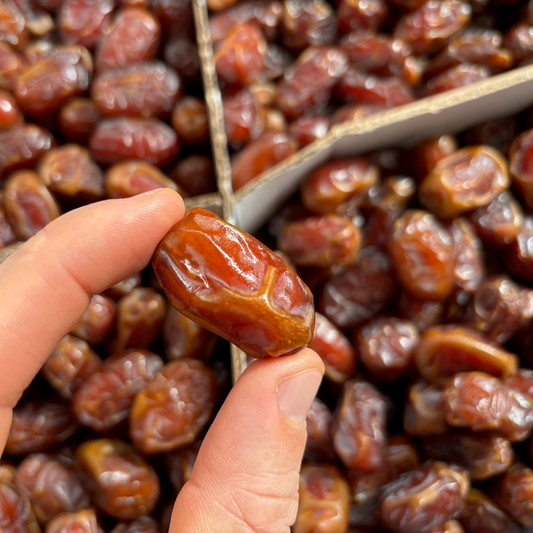fruit notes
During one of our visits to Condor Ridge Ranch last year, I noticed some young loquat trees planted in a neat row along a path on a south-facing hillside. The trees were short but the leaves were striking – oblong, green and leathery, their glossy sheen beckoning. Like many other fruits, I had asked (bugged, begged) farmer Jay Ruskey about this one for a few years now. But now I had them in my sights. The farm has a lot going on – hundreds of varieties of fruit, often planted in service of each other, whose purpose is not always necessarily the fruit itself. These loquat trees, for instance, do an amazing job of providing windbreak for the coffee shrubs planted on the hillside below. Loquat trees grow fast and produce a lot of thick foliage, making them a good match for the strong winds that sometimes come off the Pacific. Typically, loquats aren’t really grown commercially because of how sensitive the fruit is. Even with delicate handling, they bruise each other on contact, which doesn’t harm the taste but it makes for an unappealing market presentation. On top of that, the fruits form in clusters at the very top of the tree so harvest is difficult. But this year, the young trees are finally producing, the fruit is beautiful, and Jay is humoring my persistence!
Loquats are another special fruit I grew up eating that’s really important to my family. The fruit is native to southeast China, where my family is from. It’s one of the earliest cultivated fruits in Asia with reports dating back 2000 years. Growing up, we’d occasionally see some pretty tired looking fruit at the Asian grocery stores. But luckily, loquats are well-adapted to the our climate and most of what we ate came from family and friends’ backyard trees. (In fact, loquats are one of the most-widely planted ornamental trees around the Bay Area. Learn to ID it and you'll start to see them everywhere.) My family loves soft textures, so I grew up eating them with the skin peeled off. It’s very satisfying to peel back, coming off in long leathery strips. (But to be honest, I was a pretty lazy kid so my fond memories are of my grandma peeling a bowl of loquats – lucky me!) The flesh has a juicy and succulent texture that is similar to a meaty plum, with a really nice tartness that adds a citrusy note. There’s often 2-3 round seeds in the middle, so make sure you have a little “pit bowl” ready, like when you’re eating cherries :)
Jay has a few trees that are a variety called “Big Jim”, producing oblong fruit. The rest of the fruit are from seedling stock of other “good” cultivars. (When I quizzed him on the specific varieties, Jay just reassured me they’re “good”.) I hope you agree! Store loquats in the fridge. Grown organically by Condor Ridge Ranch in Goleta.
Booth cherimoya tastes like banana, papaya, and pineapple! Leave on the counter to ripen. The cherimoya is ready to eat when it has a little give (like an avocado) and the skin starts to brown slightly. Once it’s ripe to your liking we recommend popping it in the fridge to chill for a bit. Cut in half and eat with a spoon, avoiding the inedible seeds. Grown organically by Condor Ridge Ranch in Goleta.
First of the season Snowchaser blueberries from Coastal Moon! Store in the fridge. Grown organically by Coastal Moon Farm in Watsonville.
The cult-classic Ojai Pixie mandarins! Ojai is the perfect microclimate for growing sweet, and flavorful PIxie mandarins! It’s the last mandarin of the season. Store on the counter. Grown organically by Churchill Orchard in Ojai.
Classically sweet-tart Ruby Red grapefruit. Our friends at Terra Firma JUST started harvesting these. They are our favorite late-season and super flavorful grapefruit! Store on the counter. Grown organically by Terra Firma Farm in Winters.
These classic Hayward kiwis are a familiar variety but farmer Ruthanne measures the sugars and waits to harvest until they are nearly double the standard of big, commercial growers. Enjoy firm or keep on the counter until they’re softer. Grown organically by Shared Abundance Organic Farm in Auburn.





